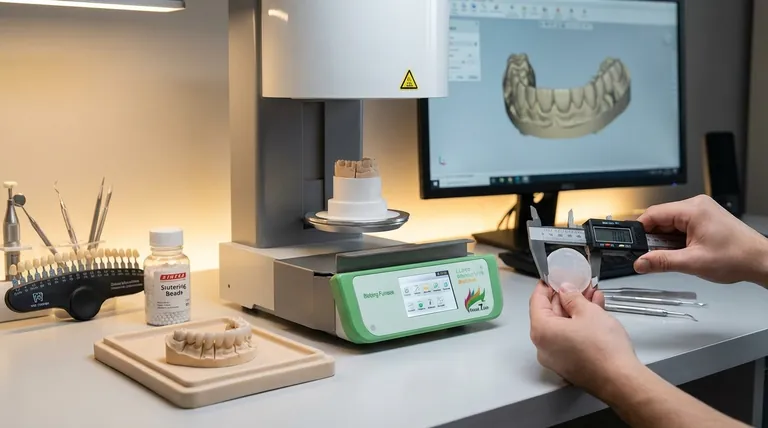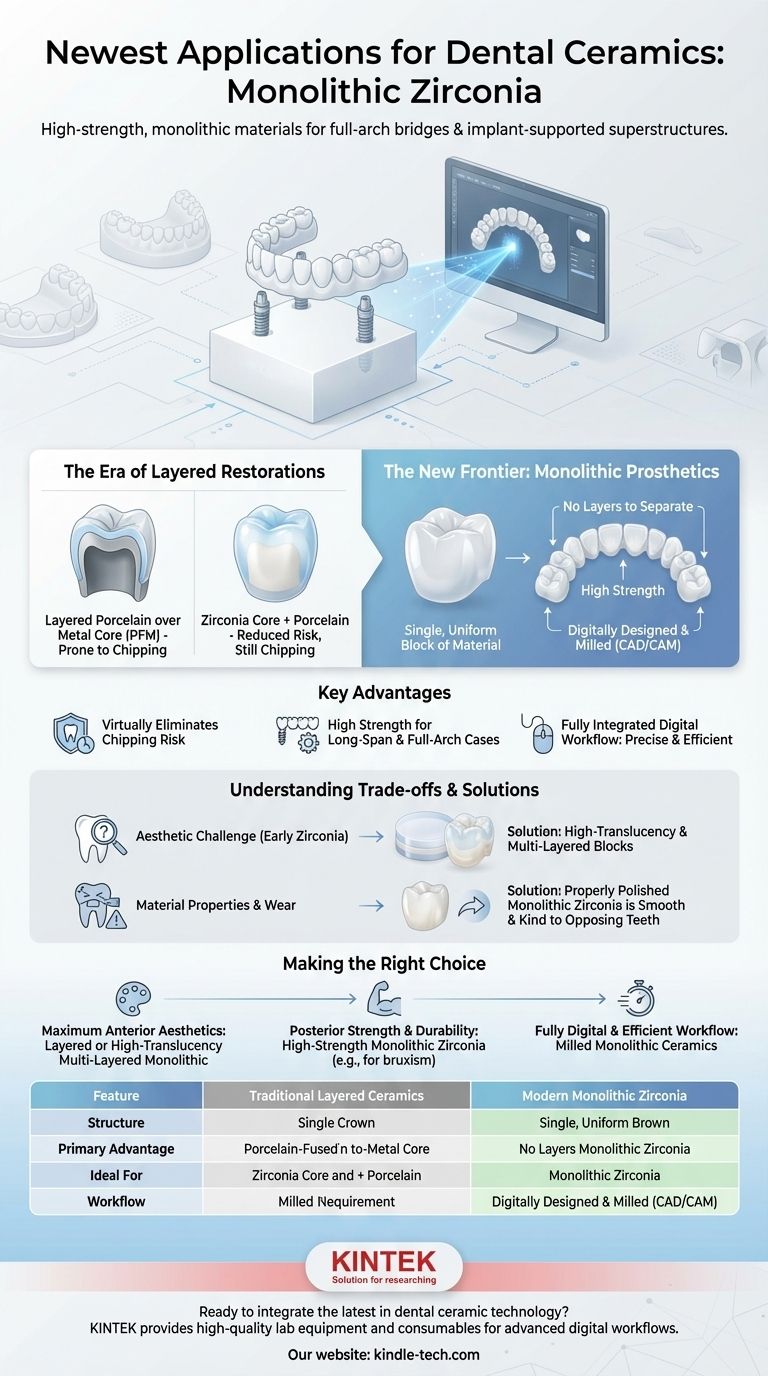One of the most significant new applications for dental ceramics is the use of high-strength, monolithic materials like zirconia for full-arch bridges and implant-supported superstructures. While ceramics have long been used for crowns and as components in composites, modern advancements in material science now allow for complete prostheses to be milled from a single block of ceramic, eliminating the need for a metal substructure and revolutionizing durability and digital workflows.
The core evolution in dental ceramics is a shift away from weaker, layered materials toward high-strength monolithic restorations. This change, driven by advances in zirconia, enables stronger, more predictable, and more efficiently produced prostheses for complex cases that were once the exclusive domain of metal-based solutions.

The Evolution from Traditional to Modern Ceramics
To understand the impact of this new application, it's essential to recognize the limitations of previous ceramic technologies. The history of dental ceramics has been a constant quest for a material that is both strong and beautiful.
The Era of Layered Restorations
Historically, achieving lifelike aesthetics required layering weaker, translucent porcelain over a stronger core. The most common example was the Porcelain-Fused-to-Metal (PFM) crown.
A PFM restoration provided adequate strength from its metal substructure, but the overlying porcelain was prone to chipping. This layering process was also technique-sensitive and could not be fully automated.
The Rise of High-Strength Cores
The introduction of zirconia as a core material was a major breakthrough. It was strong enough to replace the metal substructure in crowns and bridges, offering better biocompatibility and eliminating the dark metal margin at the gumline.
However, early generations of zirconia were very opaque and chalky-white. Therefore, they still required a layer of more aesthetic porcelain on the outside, meaning the risk of chipping, while reduced, was not eliminated.
The New Frontier: Monolithic Prosthetics
The newest application—the monolithic restoration—solves the core problems of older, multi-layered systems.
What is a Monolithic Restoration?
A monolithic restoration is a prosthesis fabricated from a single, solid block of a uniform material. There is no separate core and no weaker outer layer of porcelain.
The entire crown, bridge, or implant superstructure is digitally designed (CAD) and then milled from a block of high-strength ceramic (CAM), most commonly a modern translucent zirconia.
Why This is a Significant Advance
This approach offers three primary advantages. First, it virtually eliminates the risk of chipping, as there are no layers to separate. The restoration is uniformly strong throughout.
Second, the strength of modern zirconia allows it to be used in high-stress applications like long-span bridges and full-arch implant cases, which previously required the rigidity of a metal framework.
Third, it fully integrates into a digital workflow. A clinician can scan the patient, design the prosthesis on a computer, and mill the final product with extreme precision, improving consistency and efficiency.
Understanding the Trade-offs
While monolithic ceramics represent a major step forward, no material is without its considerations. Understanding these trade-offs is key to clinical success.
The Aesthetic Challenge
The primary trade-off has historically been aesthetics. Early monolithic zirconia was too opaque for use in highly visible areas like front teeth.
However, manufacturers have developed newer high-translucency and multi-layered zirconia blocks that blend different shades and translucencies within a single puck. This allows for beautiful monolithic restorations that rival the aesthetics of layered porcelain without sacrificing strength.
Material Properties and Wear
Zirconia is an extremely hard material, which initially raised concerns about it wearing down the opposing natural teeth.
Extensive research has since shown that it is the roughness of a material, not its hardness, that causes wear. A properly polished monolithic zirconia restoration is exceptionally smooth and has been proven to be very kind to the opposing dentition.
Making the Right Choice for Your Application
The expansion of ceramic options means the material must be matched to the clinical goal.
- If your primary focus is maximum anterior aesthetics: A layered porcelain restoration or a monolithic restoration made from a high-translucency, multi-layered block may still provide the most vibrant and lifelike results.
- If your primary focus is posterior strength and durability: A monolithic high-strength zirconia restoration is the undisputed standard, especially for patients who grind their teeth (bruxism) or for multi-unit bridges.
- If your primary focus is a fully digital and efficient workflow: Milled monolithic ceramics offer the most predictable and streamlined path from digital impression to final, durable prosthesis.
Ultimately, the advent of monolithic ceramic applications has fundamentally expanded the dentist's toolkit, enabling stronger, more reliable, and aesthetically pleasing outcomes for patients.
Summary Table:
| Feature | Traditional Layered Ceramics | Modern Monolithic Zirconia |
|---|---|---|
| Structure | Weaker porcelain layered over a core (e.g., metal) | Single, solid block of ceramic |
| Primary Advantage | Good aesthetics | Superior strength and durability; eliminates chipping |
| Ideal For | Single crowns, low-stress areas | Full-arch bridges, implant cases, patients with bruxism |
| Workflow | Technique-sensitive, manual layering | Fully digital (CAD/CAM), efficient and predictable |
Ready to integrate the latest in dental ceramic technology into your practice? KINTEK specializes in providing high-quality lab equipment and consumables that support the advanced digital workflows required for milling monolithic zirconia restorations. Our solutions help dental laboratories achieve the precision, strength, and efficiency needed for these groundbreaking applications. Contact us today to learn how we can support your laboratory's success with the right tools for modern dentistry.
Visual Guide

Related Products
- Dental Porcelain Zirconia Sintering Ceramic Furnace Chairside with Transformer
- Laboratory Muffle Oven Furnace Bottom Lifting Muffle Furnace
- 1400℃ Laboratory High Temperature Tube Furnace with Alumina Tube
- 1700℃ Laboratory High Temperature Tube Furnace with Alumina Tube
- Vertical Laboratory Tube Furnace
People Also Ask
- What makes zirconia translucent? The Science Behind Modern Dental Aesthetics
- What is the sintering temperature of zirconium? A Guide to the 1400°C-1600°C Range for Dental Labs
- What is the sintering time for zirconia? A Guide to Precise Firing for Optimal Results
- What is a dental oven? The Precision Furnace for Creating Strong, Aesthetic Dental Restorations
- What is the price of zirconia sintering furnace? Invest in Precision, Not Just a Price Tag



















